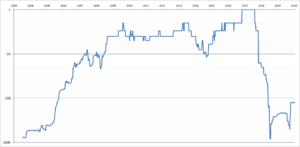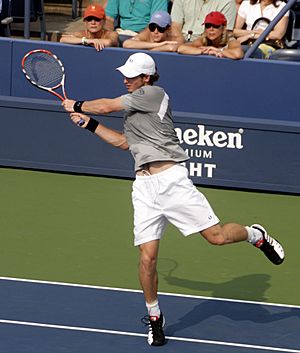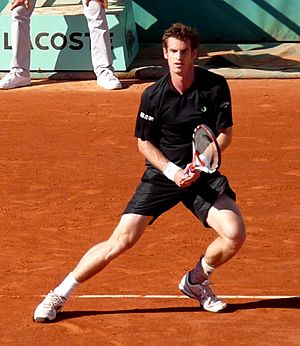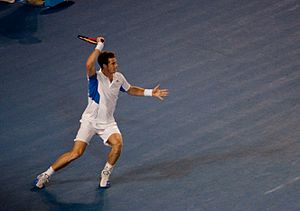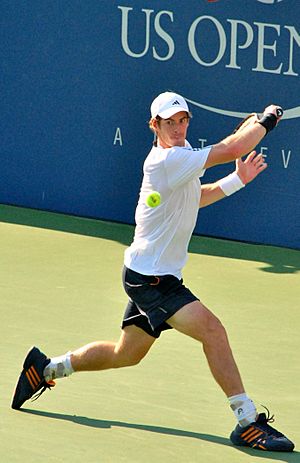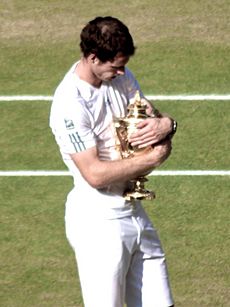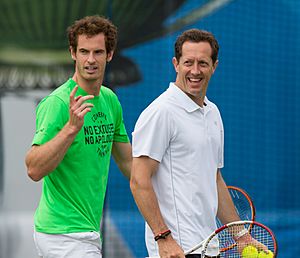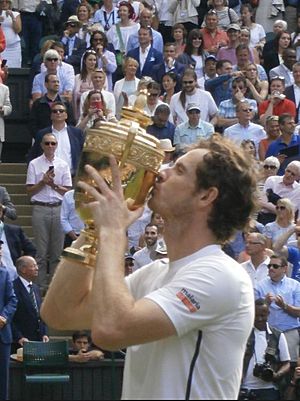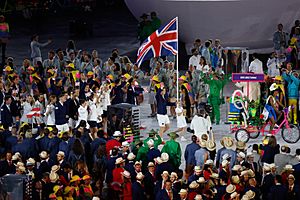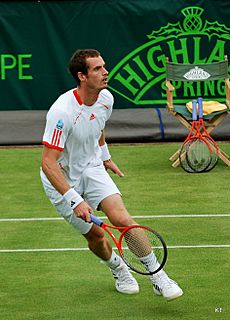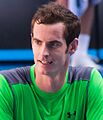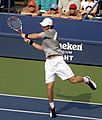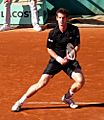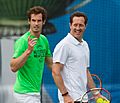Andy Murray facts for kids
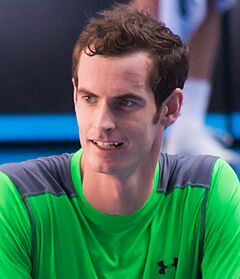
Murray at the 2015 Australian Open
|
||||||||||||||||||||
| Full name | Andrew Barron Murray | |||||||||||||||||||
|---|---|---|---|---|---|---|---|---|---|---|---|---|---|---|---|---|---|---|---|---|
| Country (sports) | ||||||||||||||||||||
| Residence | Leatherhead, Surrey, England | |||||||||||||||||||
| Born | 15 May 1987 Glasgow, Scotland |
|||||||||||||||||||
| Height | 6 ft 3 in (1.91 m) | |||||||||||||||||||
| Turned pro | 2005 | |||||||||||||||||||
| Retired | 1 August 2024 | |||||||||||||||||||
| Plays | Right-handed (two-handed backhand) | |||||||||||||||||||
| Coach | Ivan Lendl (2012–2014, 2016–2017, 2022–2023) | |||||||||||||||||||
| Prize money | US$64,687,542
|
|||||||||||||||||||
| Singles | ||||||||||||||||||||
| Career record | 739–262 (73.83%) (73.8%) | |||||||||||||||||||
| Career titles | 46 (15th in the Open Era) | |||||||||||||||||||
| Highest ranking | No. 1 (7 November 2016) | |||||||||||||||||||
| Grand Slam singles results | ||||||||||||||||||||
| Australian Open | F (2010, 2011, 2013, 2015, 2016) | |||||||||||||||||||
| French Open | F (2016) | |||||||||||||||||||
| Wimbledon | W (2013, 2016) | |||||||||||||||||||
| US Open | W (2012) | |||||||||||||||||||
| Other tournaments | ||||||||||||||||||||
| Tour Finals | W (2016) | |||||||||||||||||||
| Olympic Games | W (2012, 2016) | |||||||||||||||||||
| Doubles | ||||||||||||||||||||
| Career record | 83–86 (49.11%) (49.1%) | |||||||||||||||||||
| Career titles | 3 | |||||||||||||||||||
| Highest ranking | No. 51 (17 October 2011) | |||||||||||||||||||
| Grand Slam doubles results | ||||||||||||||||||||
| Australian Open | 1R (2006) | |||||||||||||||||||
| French Open | 2R (2006) | |||||||||||||||||||
| Wimbledon | 2R (2019) | |||||||||||||||||||
| US Open | 2R (2008) | |||||||||||||||||||
| Other doubles tournaments | ||||||||||||||||||||
| Olympic Games | QF (2020, 2024) | |||||||||||||||||||
| Mixed doubles | ||||||||||||||||||||
| Career record | 7–4 (63.64%) | |||||||||||||||||||
| Career titles | 0 | |||||||||||||||||||
| Grand Slam mixed doubles results | ||||||||||||||||||||
| Wimbledon | 3R (2019) | |||||||||||||||||||
| Other mixed doubles tournaments | ||||||||||||||||||||
| Olympic Games | F (2012) | |||||||||||||||||||
| Team competitions | ||||||||||||||||||||
| Davis Cup | W (2015) | |||||||||||||||||||
| Hopman Cup | F (2010) | |||||||||||||||||||
| Coaching career (2024–2025) | ||||||||||||||||||||
|
Novak Djokovic (2024–2025)
|
||||||||||||||||||||
|
Medal record
|
||||||||||||||||||||
Sir Andrew Barron Murray (born May 15, 1987) is a British former professional tennis player and coach. He was once ranked as the world No. 1 in men's singles. He held this top spot for 41 weeks, including the end of 2016.
Murray won 46 singles titles during his career. These include three major championships: the 2012 US Open, 2013 Wimbledon, and 2016 Wimbledon. He also earned two gold medals at the Summer Olympics. He won the 2016 ATP World Tour Finals and 14 Masters events. He reached a total of eleven major finals.
Andy was first coached by his mother, Judy, along with his older brother Jamie. At age 15, he moved to Barcelona, Spain, to train at a special tennis academy. He started his professional career when Roger Federer and Rafael Nadal were the top players. Murray quickly found success on the ATP Tour. He entered the top 10 rankings in 2007 when he was just 19.
By 2010, Murray and Novak Djokovic joined Federer and Nadal. This group became known as the "Big Four". They dominated men's tennis for much of the 2010s. Murray faced challenges against the other Big Four players. He lost his first four major finals, three to Federer and one to Djokovic.
His big breakthrough came in 2012. He beat Federer to win the London Olympics. Then, he defeated Djokovic to win the US Open. This made him the first British major singles champion since Virginia Wade in 1977. In 2013, he beat Djokovic again to win Wimbledon. He was the first British man to win the home championship since Fred Perry in 1936.
Murray had his best year in 2016. He reached three major finals and won Wimbledon. He also won his second gold medal at the 2016 Rio Olympics. This made him the only tennis player, male or female, to win two Olympic singles gold medals. In 2016, Murray became world No. 1 for the first time. He secured the year-end No. 1 ranking by winning the Tour Finals against Djokovic.
After 2016, Murray struggled with a hip injury. He needed major surgery and his ranking dropped outside the top 100 in 2018. After returning, he won a tour title at the 2019 European Open. He climbed back into the top 50. Murray officially retired from playing tennis after the 2024 Paris Olympics.
Murray was known as an all-court player. He was especially good at defense, returning serves, and building up points. Many considered his two-handed backhand to be one of the most consistent on the ATP Tour. Murray is credited with helping Great Britain become a strong force in men's tennis again. He and his brother led the Great Britain Davis Cup team to win the Davis Cup in 2015.
Murray has always spoken out about equality. He was only the second top-10 male player to have a female coach. He hired Amélie Mauresmo in 2014. After his playing career, Murray started coaching his former rival Djokovic for the 2025 Australian Open.
Contents
- Early Life and Family
- Junior Career Highlights
- Becoming a Professional Player
- Major Successes
- 2010: Australian Open Final
- 2011: Consistent Performance
- 2012: Olympic Gold and US Open Champion
- 2013: Wimbledon Champion
- 2014: Challenges and New Coach
- 2015: Davis Cup Champion and World No. 2
- 2016: Wimbledon, Olympic Gold, and World No. 1
- 2017: Injury and Break
- 2018: Hip Surgery and Return
- 2019: Surgery and First Title in Two Years
- Later Career and Retirement
- Rivalries
- Playing Style
- Endorsements and Equipment
- Coaches
- Charitable Work
- Images for kids
- Awards and Honours
- See also
Early Life and Family
Andy Murray was born in Glasgow, Scotland. His mother is Judy Murray and his father is William Murray. His grandfather, Roy Erskine, was a professional footballer in the 1950s. Andy supports Hibernian Football Club and Arsenal Football Club.
Murray started playing tennis at age three. His mother, Judy, took him to the local courts. He played his first tournament at five and competed with adults by age eight. His older brother, Jamie, is also a professional tennis player.
Andy grew up in Dunblane, Scotland. He and Jamie were at Dunblane Primary School during a tragic event in 1996. Murray was very young and has rarely spoken about it. He later attended Dunblane High School.
His parents separated when he was 10. The boys lived with their father, but their mother continued to coach them in tennis. Murray believes this helped make him very competitive. At 15, he was asked to train with Rangers Football Club for football. But he chose to focus on tennis.
He then moved to Barcelona, Spain. He trained on clay courts at the Sánchez-Casal Academy. He also studied at the Schiller International School. Murray called this time "a big sacrifice." His parents paid a lot for his 18-month stay. In Spain, he trained with Emilio Sánchez, a former world No. 1 doubles player.
Murray was born with a condition called bipartite patella. This means his kneecap stayed as two separate bones. It was found when he was 16. This condition caused him pain and made him withdraw from some tournaments.
In 2013, Murray bought Cromlix House hotel near Dunblane. He reopened it in 2014. He also received special honors from Stirling and the University of Stirling.
Murray started dating Kim Sears in 2005. She is the daughter of tennis coach Nigel Sears. They got engaged in 2014 and married on April 11, 2015. They have a son and three daughters.
Murray has often supported women players and coaches. He also supports LGBT+ rights and same-sex marriage. In 2020, he supported the Black Lives Matter movement. He and other players took a knee during a tournament.
Junior Career Highlights
Leon Smith, Murray's coach from age 11 to 17, called him "unbelievably competitive." Murray says losing to his older brother Jamie motivated him. In 1999, Murray won the Orange Bowl, a big junior tournament, in the 12-year-old group.
In 2001, Murray played in the Petits As tournament for players under 14. Here, his rivalry with Novak Djokovic began. Murray beat Djokovic 6–0, 6–1 in the quarterfinals. He finished the season as the No. 2 player in Europe for under-14s, just behind Djokovic.
In 2003, Murray started playing on the Challenger and Futures circuits. He reached the quarterfinals of the Manchester Challenger. In September, he won his first senior title at the Glasgow Futures event.
Murray had a knee injury for the first six months of 2004. In July 2004, he played a Challenger event in Nottingham. He lost to future Grand Slam finalist Jo-Wilfried Tsonga. Murray then won Futures events in Xàtiva and Rome.
In September 2004, he won the Junior US Open. He was chosen for the Davis Cup team but did not play. Later that year, he won BBC Young Sports Personality of the Year. As a junior, Murray reached No. 6 in the world in 2003.
Becoming a Professional Player
2005: First Steps as a Pro
Murray started 2005 ranked No. 407. He injured his back in January and took three months off. In March, he became the youngest Briton to play in the Davis Cup. Murray turned professional in April. He played in a clay-court tournament in Barcelona, losing in three sets.
In April, Murray stopped working with his coach, Pato Alvarez. He felt Alvarez was too negative. Murray then reached the semifinals of the boys' French Open. Mark Petchey became his new coach.
Murray got a special entry to Queen's. He won his first ATP match there. He reached the third round but lost due to cramps and an ankle twist. Murray then received a special entry for Wimbledon. Ranked No. 312, he became the first Scot in the Open Era to reach the third round at Wimbledon. He lost to David Nalbandian after leading by two sets.
Murray won Challenger events in Aptos and Binghamton, New York. At Cincinnati, he lost to No. 4, Marat Safin. At the US Open, he won his first five-set match. But he lost in the second round. Murray played in the Davis Cup again, losing his match.
He reached his first ATP final at the Thailand Open. He lost to No. 1 Roger Federer. Murray beat Tim Henman in their first meeting at the Basel Swiss Indoors. He finished the year ranked No. 64. He was named the 2005 BBC Scotland Sports Personality of the Year.
2006: British No. 1
In 2006, Murray played his first full season. He split with Mark Petchey and started working with Brad Gilbert. In February, at San Jose, Murray beat a top ten player for the first time, Andy Roddick. He won the title, beating Lleyton Hewitt. This made Murray the British No. 1, ending Tim Henman's seven-year run.
Murray lost early at the Australian Open and French Open. He reached the fourth round for the first time at Wimbledon and the US Open. At Wimbledon, he beat 3rd seed Andy Roddick.
Murray played in Davis Cup matches. He reached his first Masters semifinal in Toronto, losing to Richard Gasquet. At Cincinnati, Murray beat Roger Federer. This ended Federer's 55-match winning streak on hard courts. Murray finished the year ranked 17th.
2007: Top 10 Ranking
Murray reached the fourth round of the Australian Open. He lost a five-set match to No. 2, Rafael Nadal. After the Miami Masters, Murray reached the No. 10 ranking on April 16.
He injured his wrist in May, missing Wimbledon. He still rose to No. 8 but dropped to No. 14 by August. Murray lost in the third round at the US Open. He reached semifinals at Indian Wells and Miami. Murray won titles in San Jose and St. Petersburg. He finished the season ranked 11th. In November, Murray split with Brad Gilbert. He built a team of experts, with Miles Maclagan as his main coach.
2008: First Major Final
In 2008, Murray lost early at the Australian Open and French Open. He reached his first Grand Slam quarterfinal at Wimbledon. He then made his first major final at the US Open. At Wimbledon, he beat Richard Gasquet in a thrilling five-set match. He then lost to Rafael Nadal.
At the US Open, Murray beat Nadal for the first time. This made him the first British player since Greg Rusedski in 1997 to reach a major final. In the final, he lost to Federer. At the Beijing Olympics, Murray lost in the first round.
Murray won his first Masters title in Cincinnati. He won another in Madrid. He qualified for the Masters Cup for the first time. He beat Federer but lost in the semifinals. Murray ended 2008 ranked No. 4. He also won tournaments in Doha, Marseille, and St Petersburg.
2009: World No. 2
At the Qatar Open, Murray beat Andy Roddick in the final. At the Australian Open, he reached the fourth round. Murray won Rotterdam, beating No. 1, Nadal. He lost to Nadal in the final at Indian Wells. But he won a week later in Miami, beating Djokovic for another Masters title.
Murray beat Nikolay Davydenko on clay for the first time at Monte Carlo. He reached the quarterfinals of the French Open. On May 11, 2009, Murray reached the No. 3 ranking. This was the highest ranking for a British male player in the Open Era.
Murray won his first title on grass at Queen's. He was the first British winner there since 1938. At Wimbledon, his fourth-round match was the first played entirely under the new roof. He lost a close semifinal to Andy Roddick.
At Montreal, he won the title and moved to world No. 2. He held this spot until the US Open. At the US Open, Murray was bothered by a wrist injury and lost early. He missed six weeks with the injury. Murray ended the year ranked 4th.
Major Successes
2010: Australian Open Final
Murray reached his second Grand Slam Final in Australia, beating Nadal before losing to Federer. At the BNP Paribas Open in Indian Wells, Murray lost in the quarterfinals. He lost early at the 2010 Sony Ericsson Open and Monte-Carlo Rolex Masters.
At the French Open, he lost in the fourth round. At Wimbledon, Murray reached the semifinals, losing to Nadal. In July, Murray and his coach Maclagan split. Murray started working with Àlex Corretja.
Murray reached the final of the 2010 Farmers Classic, losing to Sam Querrey. In Canada, Murray became the first player since Andre Agassi in 1995 to defend the Canadian Masters. He beat Nadal and Federer to end an eight-month title drought. At Cincinnati, Murray lost in the quarterfinals due to heat. He lost early at the US Open.
At China Open, Murray reached the quarterfinals. He then won the Shanghai Rolex Masters, beating Roger Federer. He did not lose a set in the tournament. In doubles, Murray partnered his brother Jamie to the final, winning his first doubles title. Murray ended the year ranked 4th for the third year in a row.
2011: Consistent Performance
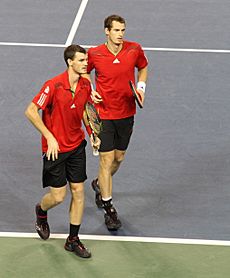
At the Australian Open, Murray lost to Novak Djokovic in the final. He lost early in Rotterdam and at the Masters Series events in Indian Wells and Miami. After these losses, he split with coach Àlex Corretja.
Murray returned to form at Monte Carlo, reaching the semifinals. He then sustained an elbow injury. Murray reached his first semifinal at the French Open, losing to Rafael Nadal.
Murray won his second Queen's Club title. At Wimbledon, he lost to Nadal in the semifinal. Murray led the British team to victory in the Davis Cup tie against Luxembourg. He won the 2011 Western & Southern Open after Novak Djokovic retired due to injury. At the US Open, Murray reached the semifinals. This was the first time he reached the quarterfinals or better at all four Grand Slams in one year.
Murray won the Thailand Open. At the Japan Open, he beat Rafael Nadal. He then won the doubles with his brother Jamie. This made him the first player in 2011 to win both singles and doubles titles at the same event. Murray then defended his Shanghai Masters title. He withdrew from the ATP World Tour Finals due to a groin injury. Murray ended the year ranked 4th.
2012: Olympic Gold and US Open Champion
With Ivan Lendl as his new coach, Murray won Brisbane. At the 2012 Australian Open, he reached the semifinals. He lost a nearly five-hour match to Novak Djokovic.
At Dubai, Murray beat Djokovic in the semifinals but lost to Roger Federer in the final. He reached the final of the Miami Masters, losing to Djokovic. Murray struggled on clay, with early losses at several tournaments. He battled back spasms at the French Open, losing in the quarterfinals.
Murray lost early at Queen's. At Wimbledon, he set a record for the latest finish for a match. He beat Jo-Wilfried Tsonga to become the first British man to reach the Wimbledon final since 1938. In the final, he lost to Federer.
Murray returned to Wimbledon for the London 2012 Summer Olympics. He and Laura Robson won a silver medal in mixed doubles. In singles, Murray beat Federer in the final. He became the first British man to win Olympic singles gold in tennis since 1908.
At the US Open, Murray reached his second Grand Slam final in a row. He beat Djokovic in five sets. This made him the first British man to win a Grand Slam final since Fred Perry in 1936. It was also the first time a Scottish-born player won a Grand Slam final since 1896. This win made Murray part of the "Big Four" in tennis.
Murray lost in the semifinals of the Japan Open. At Shanghai, Murray beat Roger Federer. He lost a close final to Djokovic. Murray finished the year at No. 3. He won the World Breakthrough of the Year at the Laureus World Sports Awards. Murray was appointed Officer of the Order of the British Empire (OBE) in 2013 for his services to tennis.
2013: Wimbledon Champion
Murray won Brisbane. At the Australian Open, he beat Federer in the semifinals. This was his first Grand Slam win over Federer. Murray lost to Djokovic in the final. He became only the second man in the Open Era to be a runner-up three times at the Australian Open.
At Indian Wells, Murray lost in the quarterfinals. In the Miami final, he beat David Ferrer. This win made him world No. 2, moving past Roger Federer. Murray briefly fell to No. 3 but quickly regained No. 2. He lost in the quarterfinals in Madrid.
Murray retired from a match in Rome due to a hip injury. This meant he had little time to prepare for the French Open. Murray withdrew from the French Open with a back injury. He returned at Queen's, winning his third title there.
Going into Wimbledon, Murray had not lost on grass since the previous year's final. He reached his tenth Grand Slam quarterfinal in a row. Murray came back from two sets down to win against Fernando Verdasco. He then beat Jerzy Janowicz to reach his second Wimbledon final. He faced Novak Djokovic again.
Murray beat Djokovic in straight sets in the final. This made him the first British man to win the Wimbledon singles title since Fred Perry in 1936. His winning streak on grass reached 18 matches.
At the US Open, Murray was the defending champion. He reached the quarterfinals but lost to Stanislas Wawrinka. This ended his streak of four consecutive major finals. The Great Britain Davis Cup team played Croatia. Murray won his matches, helping Britain return to the World Group.
After the Davis Cup, Murray had surgery for his lower back problems. At the end of 2013, Murray was voted the 2013 BBC Sports Personality of the Year.
2014: Challenges and New Coach
At Qatar, Murray won his first match easily. But he lost in the second round. At the Australian Open, Murray lost to Roger Federer in the quarterfinals. This ended his streak of four straight Australian Open semifinals. His ranking fell to No. 6.
In the Davis Cup, Great Britain played the United States. Murray won both his matches, helping Britain reach their first Davis Cup quarterfinal since 1986. Murray lost in the quarterfinals of Rotterdam. He lost in the semifinals of the Mexican Open.
At Indian Wells, Murray lost in the fourth round. Murray and coach Ivan Lendl split. At Miami, Murray lost to Djokovic in the quarterfinals. In the Davis Cup quarterfinals against Italy, Murray won his singles and doubles matches. But Great Britain lost the tie.
At Madrid, Murray lost early. He reached the quarterfinals of Rome, losing to Rafael Nadal. At the French Open, Murray reached the semifinals, matching his best result there. He lost to Nadal. Murray then hired Amélie Mauresmo, a former women's world No. 1, as his coach. This was a big step, as she was the first woman to coach a top male tennis player.
At Wimbledon, Murray lost in the quarterfinals. This ended his 17-match winning streak on Wimbledon grass. His ranking dropped to No. 10, his lowest since 2008.
Murray reached back-to-back quarterfinals at the Canadian Open and Cincinnati Masters. He lost in the quarterfinals of the 2014 US Open to Novak Djokovic. This was the first season since 2009 that Murray did not reach a Grand Slam final. His ranking fell outside the top 10.
At Shenzhen Open, Murray reached his first final in 14 months. He won the title after saving five championship points. At Beijing, he reached the semifinals. He lost early at the Shanghai Masters. In Vienna, he won his second title of the season. He won his 30th career title. Murray won another title at Valencia, again saving five championship points. He reached the quarterfinals of the Paris Masters. His wins guaranteed him a spot at the ATP World Tour Finals.
At the ATP World Tour Finals, Murray lost two of his three group matches. He was eliminated from the tournament. At the end of the season, Murray parted ways with his training partner and fitness coach.
2015: Davis Cup Champion and World No. 2
At the Australian Open, Murray reached his fourth final there. He lost to Novak Djokovic in four sets. But he returned to the top four in the world rankings. At Rotterdam, Murray lost in the quarterfinals. At Dubai, he lost in the quarterfinals.
In the Davis Cup in Glasgow, Murray won both his singles matches. This helped Great Britain reach the quarterfinals. Murray reached the semifinals of Indian Wells. He passed Tim Henman for the most career wins by a British man in the Open Era. He lost to Djokovic again. Murray reached the final of Miami, recording his 500th career win. He lost to Djokovic. Murray added Jonas Björkman to his coaching staff.
Murray won his first ATP clay court title at the 2015 BMW Open. He became the first Briton since 1976 to win a clay court event. At Madrid, he beat Rafael Nadal in the final. This was his first clay court Masters title. It was also his first win over Nadal, Federer, or Djokovic since Wimbledon 2013.
At Italian Open, he withdrew due to tiredness. Murray reached his third semifinal at the French Open. He lost to Djokovic, ending his 15-match winning streak on clay.
To start his grass court season, Murray won his fourth Queen's Club title. At the 2015 Wimbledon Championships, Murray reached the semifinals but lost to Roger Federer.
In Great Britain's Davis Cup quarterfinal against France, Murray won both his singles matches. He and his brother Jamie won the doubles. Great Britain reached their first Davis Cup semifinal since 1981.
At Citi Open, Murray lost his first match. He won Montreal, beating Djokovic in the final. This ended his eight-match losing streak against Djokovic. He also moved past Federer to become world No. 2. In doubles, he and Leander Paes lost to his brother Jamie and John Peers. This was the first time the Murray brothers played against each other in a Tour-level match.
At Cincinnati, Murray lost to Roger Federer. His ranking returned to No. 3. At the US Open, Murray came back from two sets down to win a match. He lost in the fourth round. This ended his five-year streak of reaching Grand Slam quarterfinals.
Facing Australia in the Davis Cup semifinals, Murray won both his singles matches. He and his brother Jamie won the doubles. Great Britain reached the Davis Cup final for the first time since 1978.
Murray lost in the semifinals of the Shanghai Masters to Djokovic. He reached the finals of the Paris Masters. He lost to Djokovic. At ATP World Tour Finals, Murray was eliminated in the group stage. However, he finished the season ranked No. 2 for the first time.
In the Davis Cup final, Murray won his singles matches. With his brother Jamie, he won the doubles. Murray secured a 3–1 victory for Great Britain. This was their first Davis Cup title since 1936. Murray became only the third player to win all eight of his singles matches in a Davis Cup season.
2016: Wimbledon, Olympic Gold, and World No. 1
At Australian Open, Murray reached his fifth final there. He lost to Novak Djokovic. He became the second man in the Open Era to lose five Grand Slam finals at one event. In February, Murray hired Jamie Delgado as an assistant coach. Murray played in the 2016 Davis Cup, winning his matches. At 2016 Indian Wells Masters and Miami, he lost early.
At Monte Carlo, Murray lost in the semifinals to Rafael Nadal. At 2016 Mutua Madrid Open, Murray beat Nadal but lost to Novak Djokovic in the final. This dropped Murray to No. 3 in the rankings. Shortly after, Mauresmo and Murray ended their coaching partnership.
Murray regained his No. 2 ranking after winning the 2016 Internazionali BNL d'Italia. This was his first title of the season. He beat Djokovic in straight sets. This was his first win over Djokovic on clay. At French Open, he reached the final, becoming the first British man to do so since 1937. He lost to Djokovic.
In June, Ivan Lendl returned as Murray's coach. At Queen's, Murray won his record fifth title. At the 2016 Wimbledon Championships, Murray reached his third straight major final. In the final, Murray defeated Milos Raonic to win his second Wimbledon title. This was his third major title overall.
At Rio Olympic Games, Murray became the first player to win two consecutive Olympic gold medals in singles. He beat Juan Martín del Potro in the final. Murray then played the US Open, losing in the quarterfinals.
At the Davis Cup semifinal in Glasgow, Murray lost to Juan Martín del Potro. He and his brother Jamie won the doubles. Great Britain lost the tie. Murray then won the China Open, his fifth title of 2016. He then won Shanghai.
Murray won the Erste Bank Open, his seventh title of 2016. This was his third title in a row. He won seven titles in a single season for the first time. Murray entered the Paris Masters knowing a win could make him world No. 1. Djokovic lost, and Murray became the first British man to reach No. 1 since 1973. Murray then won the Paris Masters title.
In November 2016, Murray reached the final of the ATP World Tour Finals. He beat Novak Djokovic to finish the year at No. 1. He became the first player to win a Grand Slam, the ATP World Tour Finals, Olympic gold, and a Masters 1000 title in the same year. The International Tennis Federation named Murray their 2016 men's world champion.
2017: Injury and Break
Murray was knighted in 2017 for his services to tennis and charity. He was the UK's youngest knight at 29. Murray reached the final of the Qatar Open, losing to Novak Djokovic. At the 2017 Australian Open, he lost in the fourth round.
At Dubai, he won his only tournament of the year. He beat Fernando Verdasco in the final. The next week, he lost early at the Indian Wells Masters.
Murray missed a month due to an elbow injury. He returned at the Monte-Carlo Masters, losing in the third round. He lost in the semifinals of Barcelona. Murray lost early in Madrid and Rome. In the 2017 French Open quarterfinals, he beat Kei Nishikori. He lost in the semifinals to Stan Wawrinka.
As the five-time champion at Queen's, Murray pledged his prize money to victims of the Grenfell Tower fire. However, he lost in the first round. Despite a hip injury, he played Wimbledon as the defending champion. He lost in the quarterfinals to Sam Querrey.
Murray missed the Canadian Open and the Cincinnati Masters due to his hip injury. This caused him to lose his No. 1 ranking to Rafael Nadal. His injury forced him to withdraw from the US Open. He did not play again in 2017. His ranking fell to No. 16. Murray played a charity match against Federer in Glasgow. He and Ivan Lendl ended their coaching arrangement for a second time.
2018: Hip Surgery and Return
In March, Murray lost his British No. 1 ranking to Kyle Edmund. Murray said he was making progress after hip surgery. He planned to play his first ATP tournament since surgery in June but withdrew. He returned at Queen's, losing in the first round. He played at the Eastbourne International, winning one match. He withdrew from Wimbledon because he wasn't ready for five-set matches. His ranking dropped to 839th.
At Washington, Murray won a long match that ended past 3:00 AM. He was emotional after the win. He then withdrew from the tournament and the Canadian Open. He played at the Cincinnati Masters, losing in the first round.
Murray made his Grand Slam return at the US Open. He won his first match but lost in the second round. He played at the ATP Shenzhen Open as a wildcard, reaching the quarterfinals. He ended his season early due to an ankle problem.
2019: Surgery and First Title in Two Years
At Brisbane, Murray won his first match. But he said he didn't know how much longer he could play. He lost in the next round.
On January 11, before the 2019 Australian Open, an emotional Murray announced he might retire. He had been struggling with hip pain daily. He said the Australian Open could be his last tournament. Many tennis players paid tribute to him.
At the Australian Open, Murray lost his opening match in a four-hour, five-setter. After the match, a video of tributes from other top players was shown. He said he was thinking about a second hip surgery. He hoped to return to the sport after recovering.
Bob Bryan suggested Murray have a "Birmingham hip resurfacing (BHR)" operation. Bryan said it would improve his life and might help him play professionally again. On January 29, Murray announced he had the hip resurfacing surgery. He hoped it would end his hip pain. On March 7, Murray said he was pain-free and might return to competitive tennis.
On May 16, 2019, Murray received his knighthood from Prince Charles.
Murray returned to tennis in June, playing doubles at Queen's Club Championships. He partnered with Feliciano Lopez. They won the title. Murray said his "hip felt great" and had "no pain." At Wimbledon, he and Pierre-Hugues Herbert lost in the second round of men's doubles. Murray and Serena Williams lost in the third round of mixed doubles.
In his first singles match since the Australian Open, Murray lost at Cincinnati. In doubles, he and Feliciano López played against his brother Jamie and Neal Skupski. Jamie and Skupski won. Andy decided to focus on returning to singles. He lost early at 2019 Winston-Salem Open.
Murray played a Challenger event, the 2019 Rafa Nadal Open Banc Sabadell, for the first time since 2005. He won his first singles match since his hip surgery. He lost in the third round.
Murray won the European Open, beating Stan Wawrinka in the final. In November 2019, he played for Great Britain in the Davis Cup. He played one match in their run to the semifinals.
A documentary about Murray's hip injury, Andy Murray: Resurfacing, was released in November 2019.
Later Career and Retirement
2020: Top 10 Win
Due to the COVID-19 pandemic, many tournaments were canceled or moved. Murray's first ATP tournament of 2020 was the Western & Southern Open. He beat world No. 7 Alexander Zverev, his first win over a top-10 player in over three years. He lost in the third round.
At the US Open, Murray came back from two sets down to win his first match. He lost in the second round. He then played the French Open as a wildcard but lost in the first round. Murray's last tournament of the year was the Bett1Hulks Indoors, where he lost in the first round.
2021: Wimbledon Third Round
Murray's first tournament of 2021 was the 2021 Open Sud de France, where he lost in the first round. In March, he played at the 2021 ABN AMRO World Tennis Tournament in Rotterdam, losing in the second round.
Murray was mostly inactive for three months due to a groin injury. He returned at the Queen's Club Championships, losing in the first round. At Wimbledon, he lost in the third round.
He withdrew from singles at the Olympics due to injury. In Olympic men's doubles, Murray and Joe Salisbury reached the quarterfinals.
Murray lost in the second round at the 2021 Western & Southern Open. At the 2021 Winston-Salem Open, he won one match before losing. At the US Open, he lost in five sets in the first round. The match was controversial due to his opponent's long bathroom break.
Murray reached the quarterfinals of the Moselle Open. He lost in the second round of the 2021 San Diego Open. He reached the third round of Indian Wells. He lost in the second round of the 2021 European Open. At the Vienna Open, Murray beat world No. 10 Hubert Hurkacz. At the 2021 Stockholm Open, he reached the quarterfinals, beating World No. 10 Jannik Sinner.
2022: First ATP Final Since 2019
After an early loss at the Melbourne Summer Set, Murray reached the final of the Sydney Tennis Classic. He lost in the final. At the 2022 Australian Open, he lost in the second round.
He ended his trial with coach Jan de Witt. He lost in the second round at Rotterdam. He hired Dani Vallverdu as his coach. Murray lost early at the Qatar Open and Dubai. After Vallverdu, Murray re-hired Ivan Lendl as his coach. At Indian Wells, he won his 700th tour match. He lost in the second round. At Miami, he lost in the second round.
At Madrid in April, he won two matches. He was set to play Novak Djokovic, but Murray withdrew due to illness.
At Stuttgart, Murray beat a top 5 player for the first time since 2016. He reached the final, losing to Matteo Berrettini. His ranking rose to No. 47, entering the top 50. At Wimbledon, Murray lost in the second round. He reached the quarterfinals at the Hall of Fame Open.
Murray had early losses at the Citi Open and Canadian Open. At Cincinnati, he lost in the second round. At the 2022 US Open, he lost in the third round.
2023: Three Challenger Titles
At the 2023 Australian Open, Murray played his longest career match, lasting almost six hours. He lost in the third round.
He reached the final of the 2023 Qatar ExxonMobil Open in Doha, losing to Daniil Medvedev. He also played at the 2023 Dubai Tennis Championships. At the Indian Wells Masters and Miami Open, Murray lost early.
In his European clay court season, Murray lost in the first rounds at Monte-Carlo and Madrid. He then won the Aix-en-Provence Challenger in France, his first title since 2019. He withdrew from the French Open to prepare for the grass season.
Murray began his grass court season by winning the 2023 Surbiton Trophy Challenger. He continued his winning streak at the 2023 Nottingham Open, winning another title.
At Wimbledon, he lost in the second round. At the US Open, he also lost in the second round.
2024: Retirement and Coaching
At the 2024 Dubai Tennis Championships, Murray recorded his 500th hardcourt win. In March, he ruptured ligaments in his left ankle at the Miami Open. He chose not to have surgery. He returned to play in May at a Challenger event in France, losing in the second round. He had first-round losses in singles and doubles at the French Open.
At Queen's, Murray played his 1000th career match, winning in three sets. He became the fifth active player to reach this milestone. However, he suffered another injury to his back and hip and retired during his second-round match. This was his last professional singles match.
Murray withdrew from the singles event at the 2024 Wimbledon Championships due to his back injury. He played in doubles with his brother Jamie. He was also set to play mixed doubles with Emma Raducanu, but she withdrew. His doubles match with Jamie was his last ever Wimbledon match as a professional. On July 23, 2024, Murray announced he would retire from professional tennis after the 2024 Paris Olympics. He withdrew from the singles event at the Olympics, playing only doubles. He reached the quarterfinals before officially ending his career in August 2024.
Since retiring, Murray has taken up golf. In October 2024, he won his first golf trophy. On November 23, 2024, it was announced that Murray was hired by his longtime rival Djokovic to be his head coach for the 2025 season. Murray coached Djokovic as he reached the semifinal of the 2025 Australian Open and the final of the 2025 Miami Open. On May 13, 2025, Murray and Djokovic announced they had stopped working together.
2025: Post-Retirement and Business
After his coaching role with Djokovic ended, Murray announced he plans to focus on a business career. In May 2025, he joined Redrice Ventures, a venture capital company, as an associate partner.
Rivalries
Murray vs. Djokovic
Novak Djokovic and Murray played 36 times, with Djokovic winning 25 matches. They are almost the same age, with Murray being just a week older. They trained together as teenagers. They met 19 times in tournament finals. Ten of these were at ATP Masters 1000 events, where they were tied.
They played in seven major finals. Djokovic won four times at the Australian Open and once at the French Open. Murray won at the US Open and Wimbledon. They had a nearly five-hour semifinal match at the 2012 Australian Open, which Djokovic won. Murray beat Djokovic in straight sets at the London 2012 Olympic Games.
In the 2012 Shanghai Masters final, Murray had five chances to win, but Djokovic saved them all and won the title. Their matches in Rome (2011) and Shanghai (2012) were voted ATP World Tour Match of the Year. Many saw this as a growing rivalry.
Djokovic won most of their matches after the 2013 Wimbledon final. In 2016, Murray lost to Djokovic in the Australian Open final for the fourth time. He also lost to Djokovic in the French Open final, where Djokovic completed his Career Grand Slam. Murray and Djokovic met in the final of the 2016 ATP World Tour Finals. Murray won in straight sets, finishing the year as world No. 1.
Murray vs. Federer
Murray and Roger Federer played 25 times, with Federer winning 14 matches. They played six times at Grand Slam tournaments, with Federer winning five. Federer won their first professional match. Murray led the early part of their rivalry. But Federer dominated the later part.
Federer won all their Grand Slam final meetings. Murray won six of their ATP 1000 tournaments. They met five times at the ATP World Tour Finals. In August 2012, Murray met Federer in the London 2012 Olympics final at Wimbledon. Murray defeated Federer in straight sets to win the gold medal.
In 2013, Murray beat Federer for the first time in a major, at the 2013 Australian Open semifinals. Their last major meeting was at the 2015 Wimbledon Championships semifinals, where Federer won. Murray is one of only three players to have beaten Federer 10 or more times. Their last match was at the 2015 Cincinnati Masters semifinals, which Federer won.
Murray vs. Nadal
Murray played against Rafael Nadal 24 times, with Nadal winning 17 matches. They often met at Grand Slam tournaments, nine times in total. Nadal won seven of these major matches. They never met in a major final. Murray won three of their ATP finals.
Murray lost three straight major semifinals to Nadal in 2011. At the 2014 French Open semifinal, Nadal won easily. In one of their last meetings, Murray beat Nadal on clay for the first time. This was at the Madrid Open in 2015. Murray lost to Nadal in the semifinals of the 2016 Monte Carlo Masters. Three weeks later, Murray beat Nadal in the semifinals of the 2016 Madrid Open.
Murray vs. Wawrinka
Murray and Stan Wawrinka played 23 times, with Murray winning 13 matches. Murray led on hard and grass courts, while Wawrinka led on clay. They met eight times in majors, with Wawrinka winning five. One notable match was at 2009 Wimbledon. Murray won in five sets. This was the first men's match played under the Wimbledon roof.
Wawrinka beat Murray at the 2010 US Open. He also ended Murray's title defense at the 2013 US Open quarterfinals. But Murray beat Wawrinka in the semifinals of the 2016 French Open.
Playing Style
Murray had an all-court game. He focused on defensive baseline play. In 2009, coach Paul Annacone said Murray "may be the best counterpuncher on tour today." His strengths included hitting groundstrokes with few errors. He was good at guessing where the ball would go and reacting quickly. He could switch from defense to offense with speed.
Murray had one of the best two-handed backhands on tour. He often used his forehand and a sliced backhand to make opponents play into his defensive game. Tim Henman said in 2013 that Murray might have the best lob in the game. Murray was known for being smart with his tactics on court. He often planned out points. He could suddenly hit his groundstrokes faster to surprise opponents.
Murray was one of the best at returning serves. He could block back fast serves with his great reach. His drop shot and net game were also strong. He usually came to the net to volley and finish points quickly. Murray played best on fast surfaces like grass. He won eight singles titles on grass, including Wimbledon and the 2012 Olympic Gold Medal. Hard courts were his favorite surface.
He worked hard to improve his clay court game since 2008. He won his first clay titles in 2015. He also reached his first French Open final in 2016. Murray's serve was powerful, sometimes reaching over 130 mph. But it could be inconsistent under pressure. Since 2011, under Ivan Lendl's coaching, Murray played more offensively. He also improved his second serve, forehand, and mental game. These changes were important for his success.
Endorsements and Equipment
In 2009, German company Adidas signed a five-year deal with Murray. He wore their tennis shoes and apparel. This contract allowed him to keep other sponsors on his shirt sleeve. Before Adidas, he wore Fred Perry clothes. When his Adidas contract ended, he signed a four-year deal with Under Armour in 2014. Murray signed with Castore for the 2019 season. He called this his last deal before announcing his retirement. Murray used Head rackets and appeared in their ads. In his final months, Murray switched to a Yonex racket.
Coaches
Murray had many coaches throughout his career:
- Leon Smith (1998–2004)
- Pato Álvarez (2003–2005)
- Mark Petchey (2005–2006)
- Brad Gilbert (2006–2007)
- Miles Maclagan (2007–2010)
- Àlex Corretja (2010–2011)
- Ivan Lendl (2011–2014, 2016–2017, 2022–2023)
- Amélie Mauresmo (2014–2016)
- Jonas Björkman (2015)
- Jamie Delgado (2016–2021)
- Dani Vallverdu (briefly in 2022)
Ivan Lendl was his coach from March 2022 until November 2023.
Charitable Work
Murray is a founding member of the Malaria No More UK Leadership Council. He helped launch the charity in 2009 with David Beckham. Murray made a public service announcement to help raise awareness and money for the charity. He also took part in several charity tennis events.
In June 2013, Murray played a charity doubles match. This event, called Rally Against Cancer, raised money for the Royal Marsden Cancer Charity. It was organized after his friend Ross Hutchins was diagnosed with cancer. Murray donated all his prize money from the tournament to the charity.
In June 2014, after the death of Elena Baltacha from liver cancer, Murray took part in 'Rally for Bally'. This event raised money for the Royal Marsden Cancer Charity and the Elena Baltacha Academy of Tennis. Murray received the Arthur Ashe Humanitarian of the Year award in 2014 and 2022.
Images for kids
Awards and Honours
- BBC Young Sports Personality of the Year: 2004
- BBC Sports Personality Team of the Year: 2012, 2015
- Most Titles in an ATP World Tour Season: 6 in 2009, 9 in 2016
- US Open Series Champion: 2010, 2015
- Best ATP World Tour Match of the Year (3): 2010, 2011, 2012
- Officer of the Order of the British Empire: 2013
- Laureus "World Breakthrough of the Year" Award: 2013
- Glenfiddich Spirit of Scotland Award for Top Scot: 2013
- Glenfiddich Spirit of Scotland Award for Sport: 2013
- BBC Sports Personality of the Year: 2013, 2015, 2016
- Doctor of the University of Stirling: 2014
- Freeman of Stirling: 2014
- Freeman of Merton: 2014
- Arthur Ashe Humanitarian of the Year: 2014, 2022
- ITF Player of the Year: 2016
- Knight Bachelor: 2017
- 3rd Class Order of Merit of Ukraine: 2022
See also
 In Spanish: Andy Murray para niños
In Spanish: Andy Murray para niños


